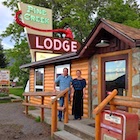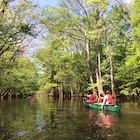
The developer's favorite name.

It doesn't get much more American than "Pine Creek". This one is north of Yellowstone and gets good reviews.

One of 244 places in 33 states named "Pine Grove Cemetery".

We have a winner! 849 U.S. places named Cedar Creek. This one, in the Congaree National Park, appears to have been named for Taxodium distichum.

A lot of places named "Spruce Creek" appear to be in locations where no spruce have ever grown (except maybe in the Pleistocene), and where the dominant trees today are palms and telephone poles.

I couldn't find a "tamarack" place name photo that even suggested the presence of tamarack trees, so here's a photo to show you why early loggers got so excited about tamaracks in the West [C.J. Earle, 2008.07.21].

Most "hemlock" place names refer to Tsuga canadensis; many names refer to water features but there are also bluffs, buttes, hills, and ridges.

Conifers in United States Place Names
Everywhere they occur, conifers are recalled in geographic names. Some of these names are tediously common; most Americans, for example, have been subjected to dozens of housing developments, motels and the like named "Whispering Pines." In the United States, we have an online listing of every place name in the country that has been approved by the U.S. Board of Geographic Names; these are the designated names used on U.S. government and most other maps. Conifer place names are recorded in every state (though Hawaii only has one, Pine Forest Drive, likely named for a plantation on Kauai), as well as the District of Columbia, Puerto Rico, the Virgin Islands, and the Marianas Islands. All told, about 1% of all place names in the U.S., which means about 25,000 places, are named for conifers. I derived this number by searching (on 2019.10.24) the U.S. Board's online database for key words associated with conifers. The list of searched key words included the following (with the number of associated names in parentheses):
BALSAM (148) CEDAR (7,201) CONIFER (23) CYPRESS (1,272) GINKGO (3) HEMLOCK (372) JUNIPER (661) LARCH (113) PINE (12,596) PINUS (3) PINYON (70) REDWOOD (362) SEQUOIA (86) SPRUCE (1,044) TAMARACK (398) TSUGA (3) YEW (28)
I didn't search for some words, most notably "fir" because the results mostly consisted of words such as "fire" or "first" that include the string "fir." I also established that many potential words had no hits, such as "Abies, Araucaria" or "Monkey" (as in monkey-puzzle, our common name for Araucaria). Here are some remarks on the most common names.
Pine
Pine, or its variants Pinus and Pinyon, is by far the most common conifer place name, accounting for 52% of all conifer place names (12,669 places). I suspect there are two reasons for this, one being that in English "pine" is a term generically applied to all evergreen conifers regardless of their taxonomic position, and the other being that especially in historic time, when a great majority of these names were first assigned, species of Pinus represented one of the dominant land cover types in the country. Yellow pines such as P. palustris and P. echinata covered most of the Atlantic and Gulf coastal plains and much of the interior of the eastern U.S. Most of the interior west was dominated by semiarid pines such as P. ponderosa, P. contorta, and the two pinyons P. edulis and P. monophylla. In the northeastern states, P. strobus and P. resinosa were often prominent in the local vegetation, and were generally among the first trees to attract attention for exploitation as timber resources. As a result, the U.S. now as 431 places named "Pine Creek," 558 places named "Pine Grove Church" or (often right next door) "Pine Grove Cemetery," and thousands more that match the words "Pine" or "Piney" with lakes, mountains, islands, springs, schools, churches, or streams.
Cedar, Cypress, and Juniper
Cedar (7,201 names), Cypress (1,272 names), and Juniper (661 names): In the U.S., these three words usually apply to species of Juniperus, and together they account for 37.5% of conifer place names. There are regional exceptions. "Cedar" can also refer to Thuja occidentalis, T. plicata, Calocedrus decurrens, Callitropsis nootkatensis, Chamaecyparis lawsoniana, or Ch. thyoides. "Cypress" can also refer to Taxodium and occasionally to Cupressus or Hesperocyparis, most often cultivated Cupressus sempervirens, which has lent its name to a variety of cemeteries and housing developments. A review of the names, however, shows that these terms are most commonly used in states where Juniperus is a dominant tree on the landscape; the most common exception is swampy or boggy areas in the ranges of Thuja occidentalis and Chamaecyparis thyoides. Juniperus is very common throughout much of the interior of the country. In arid regions it was often an indicator of surface water; thus the most common conifer place name in the U.S. is "Cedar Creek" (849 occurrences), and cedars are also recalled thousands of times in the names of churches, schools, cemeteries, springs, swamps, lakes, ponds, mountains, ridges, canyons, bluffs, tanks, parks, and a hundred synonyms for "stream."
Spruce
With "spruce" (1,044 names) we come to a word that is fairly specific; it almost always refers to Picea, although it was occasionally applied to Pseudotsuga. The name is most common in West Virginia, where Picea rubens was important in the economic development of the region, as a source of pulp and, secondarily, of timber. The name is also very common in Colorado, Kentucky, Maine, Minnesota, New York, and Pennsylvania; in the latter four states it would mainly apply to P. rubens and P. glauca, though P. mariana is also local. In Colorado it would apply to the very widespread mountain species P. engelmannii, but even more to the riparian species P. pungens, which was doubtless a common landmark on the historic landscape and is now Colorado's state tree. The most common name is "Spruce Creek" (106 uses), followed by the synonyms "Spruce Run" and "Spruce Branch."
Tamarack
This name appears 398 times. It usually refers to Larix laricina, but is also used widely in the West to refer to large, straight conifers with reddish bark and tough, strong wood that reminded loggers of the eastern species; the most common of these was Pseudotsuga menziesii but the term could also be applied to Pinus spp. 62 places outside the range of Larix have such names. Another 104 places are in the range of Larix occidentalis (Idaho, Montana, Oregon and Washington), and most of these are likely applied to that species (though all of these states also support Pinus and Pseudotsuga), which was very highly regarded as a source of timber and is still planted as such in some areas. Most remaining uses of the name are in states where L. laricina is native. In Alaska (6 uses) it was probably an incidental name, but in the other states, this species was an important source of timber, at least in historic times. There are a handfull of exceptions - one place in Florida, two in Georgia, one in Kansas, two in Missouri, one in Tennessee - that were outside the range of L. laricina and where, again, some aspect of a local tree likely reminded someone of that species. In particular, it may have been mistaken for Taxodium, the only other deciduous conifer native to the U.S.
Hemlock
The U.S. has four native hemlocks: Tsuga heterophylla and T. mertensiana on the west coast, and T. canadensis throughout much of the East, with T. caroliniana in North Carolina. In the west, T. heterophylla is by far the most common species in populated areas, so this and T. canadensis likely account for the majority of the 372 "hemlock" place names. There is a "Hemlock Meadow" in Utah, the only state with a place not in the range of Tsuga, and I suspect this is named for the poison hemlock, Conium maculatum; the same may be true of some places that are also within the range of Tsuga. Otherwise, it appears that about 21% of "hemlock" places are in the western U.S., and the remainder in the east.
Redwood and Sequoia
"Sequoia" appears in 86 names and, as expected, mostly (78%) occurs in California. The other uses are scattered through 11 states; some uses appear to be developments, and others may refer to the Cherokee teacher Sequoyah (whose name appears at 106 places), for whom "Sequoia" is a variant spelling. The surprising thing about the 362 "redwood" names is that only 63% of them are in California, where they usually apply to Sequoia, but sometimes to Sequoiadendron. There are 8 names in Oregon, which has a few native Sequoia. The name is quite common in Minnesota (41 places), where it is usually associated with the Redwood River, which was named for the reddish bark of dogwoods (Cornus stolonifera) growing along its banks. The term "redwood" is also applied to various other trees, such as the wood of Juniperus virginana, which is often very red. These variant uses likely apply to the names' occasional use in 28 states where Sequoia is not native. In only one of these, Utah, is the name used more than 10 times. Almost all of those uses are connected to the planned suburban community of Redwood; perhaps the product of a California developer?






